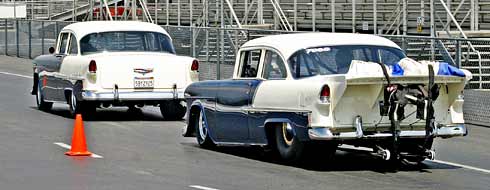
“It’s a real pretty car; it’s got a high-dollar paint job, true show quality,” Berney says of the street machine. “I actually took it and used it as my tow car at Super Chevy in Pomona. The people there just loved it.”
With the other ’55 shell still lying about, Berney says he reached the decision to build his current racecar, dubbed “Bertha Too,” nearly four years ago. Initially, he considered building the car with a full tube chassis, but after consulting with his old crew chief, Jim Dunford, decided to go with a back-half car.
“He said, ‘Why would you want to build an all-tube chassis? Think about where you enjoyed racing in the old days,’” Berney explains. “My real enjoyment was with something that actually resembles something that could be driven on the street. So we talked about it and decided we were going to do a back-half just like we did with the old car. We left the stock A-frames and ball joints in it and it probably cost me an extra $2,500 to $5,000 to do it that way because it takes a lot more to build one of those than it does a strut car because you’ve got to integrate everything into it.”
Next came the powerplant decision and Berney went with supercharging this time around. “I don’t like the turbos,” he states. “They make a lot of horsepower, but they don’t sound right; they just don’t appeal to me.”
So a 14-71 Mert Littlefield blower now sits atop a 526 cubic-inch Donovan block. Headers custom-built by Dunford expedite the engine’s spent gases through five-inch stainless steel exhaust pipes leading to a pair of round, chrome Borla mufflers before exiting NASCAR-style in front of the rear tires.
“It’s old school, no Big Chief heads, no X-motor, nothing trick. It’s got an old Indy manifold—they don’t even make it in mag, only aluminum—and I came out with a set of Star 320/360 water heads on it, but I don’t run any water in it so that was the weakest link and I’ve since switched to a set of Alan Johnson Chevrolet billet heads,” Berney says.
Chassis fabrication was handled by Jim Berg with a great deal of input from the car’s owner. “I was up there basically every weekend and said just tack all the tubes in because the only ones that are for sure are the ones we have to put in. Everything else, I just wanted a certain way because I sit in almost the stock location in the car. For example, the side tubes for the helmet bar on the Funny Car cage, I’ve got it raised so I look right out in between them. I’m just laid back a little bit, everything fits really tight.”
